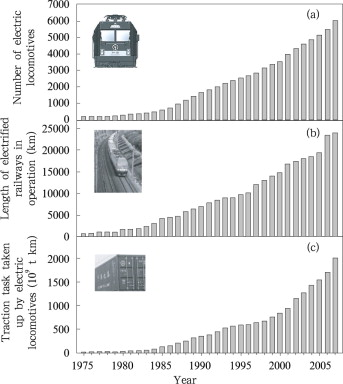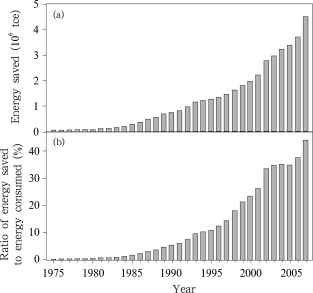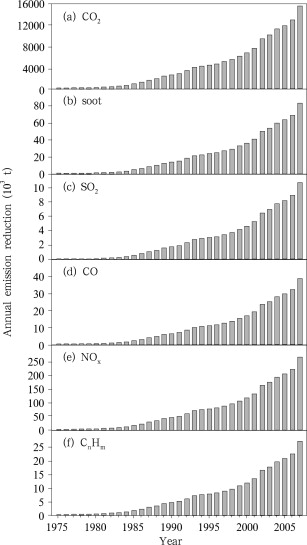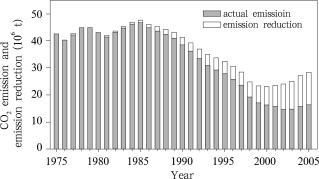Abstract
Based on the annual production data collected by the Statistic Center of the Ministry of Railways of the People’s Republic of China, we calculated the energy saving and direct emission reductions of CO2 , soot, SO2 , CO, NOx and Cn Hm of electrified railways, and analyzed their dynamic characteristics during the period of 1975–2007. The results show that during this period, the annual mean values of energy saving is 1.23×106 tce, and direct emission reduction of CO2 , soot, SO2, CO, NOx and Cn Hm are 4.267×106 t, 20.5×103 t, 3.0×103 t, 9.6×103 t, 67.9×103 t, and 6.9×103 t per year, respectively. The annual average increasing rates of energy saving is 139×103 tce, and direct emission reduction of CO2 , soot, SO2, CO, NOx and Cn Hm are 483×103 t, 2.3×103 t, 0.34×103 t, 1.1×103 t, 7.7×103 t and 0.78×103 t per year, respectively. The electrified railways have played an important role in decreasing the energy consumption and air pollutant emissions of China’s railway system. The results of this study could provide some reference knowledge for future reductions of energy consumption and waste gas emission in China’s railway transportation.
Keywords
China railways ; electrified railways ; energy saving ; emission reduction ; CO2 ; air pollutants
1. Introduction
Global change and environmental protection are important current challenge for human beings. Plenty of energy consumptions and greenhouse gases and air pollutants emissions have attracted more and more attention, causing energy saving and emission reductions to become hot topics at present [ Ding et al., 2010 ; Fang et al., 2009 ; Ding et al., 2009 ]. Energy saving and emission reduction are meant to improve energy-use efficiency, decrease energy consumption, and reduce the emissions of greenhouse gases as well as air pollutants of waste gas, waste water and other waste matters. Before the opening of the United Nations Climate Change Conference 2009 in Copenhagen, the Chinese government clearly put forward the target of controlling CO2 emission: by 2020, CO2 emission per unit of GDP should drop by 40%–45% from 2005 levels. This target has been brought into the mid-long term plans for national economic and social development as a binding index.
Presently, the studies on energy saving and emission reduction mainly focus on solving the problem of greenhouse gas emission [ Zhuang, 2008 ; He et al., 2009 ], and on corresponding policy suggestions in China [Wei et al., 2007; Zhuang, 2006 ; Chen, 2006 ]. The contents were some qualitative descriptions and calling for policy, lacking of a quantitative analysis aimed at a certain industry. The railway is an important transportation method, and is located at a core position in the traffic and transportation industry in China. In electrified railway, the trains are hauled by electric locomotives. They are characterized as high speed, low energy consumption and strong transport capacity. On August 15, 1961, the first electrified railway in China was built between Baoji and Fengzhou [ Cai, 1998 ], and from then on, electrified railway construction has been developed continuously. In recent years, as the construction of passenger dedicated railways, the scale of electrified railway will be broader, the energy consumption of railway transportation will be less, and the effects of energy saving and emission reduction will be more apparent. Some studies have predicted power demand for electrified railways [ Ren et al., 2009 ], while there are few reports of energy consumption, energy saving and emission reduction in China. Here, we quantitatively analyzed the efficiencies of energy saving and emission reduction in electrified railways in terms of a temporal scale, based on the variations in such indices as traction task and annual use of electricity of electronic locomotives in the 33 years from 1975 to 2007 in China. This will provide useful information for construction and development of electrified railways in the future.
2. Data and methods
In this study, data of all the indices of diesel locomotives and electric locomotives, the traction task, and so on, are extracted from the China Railways Compendium of Statistic and Concise Railway Statistics [ CRSC, 2009 ].
2.1. Calculation of energy saving
This study analyzed the amount of energy saved by electrified railways by using a replacement calculation method. This method is based on the fact that energy can be saved if diesel locomotives are replaced by electric locomotives to complete the same traction task. Diesel locomotives are driven by diesel oil burning equipment and electric locomotives are driven by electricity. In energy statistics, all the energy consumed must be converted to a standard fuel, that is coal equivalent (ce), which is used as the standard fuel due to the feature of coal-dominated energy structure in China. At present, the statistical standard of energy consumption has only a stipulation on equivalent and equal thermal values of electric power and their conversion standard coal coefficients [ SGAPRCQSIQ and SAPRC, 2008 ]. The amounts of energy saving in electrified railways refer to the saved end-use energy amounts. Based on the international feasible method to calculate end-use energy consumption, the equivalent coefficient, but not the equal coefficient, is used as the conversion standard coal coefficient of electric power. The formula to calculate the annual amount of energy saving from electrified railways is as follows.
|
|
( 1) |
Ei is the energy saving of electrified locomotives in the year i (106 tce), Qi is the annual traction task in the year i (109 t km), Ki is per unit of oil consumption of diesel locomotives in the year i (kg (103 t km)–1 ). The oil consumption persistently decreased from 440 kg (103 t km)–1 in 1975 to 246 kg (103 t km)–1 in 2007. Di is per unit of electricity consumption of electric locomotives in the year i (109 kW h). The annual electricity consumption consistently increased from 0.19×109 kW h in 1975 to 22×109 kW h in 2007. In the national criterion General Principles for Calculation of the Comprehensive Energy Consumption, 1.4571 is the reference coefficient for converting diesel oil to standard coal, and 0.1229 is the reference coefficient for converting electricity to standard coal equivalent [ SGAPRCQSIQ and SAPRC, 2008 ].
2.2. Calculation of emission reduction
Railway electrification can change a distributed and mobile emission source (diesel locomotives) into a concentrated and immobile emission source (coal-fired power plants). For the railway industry, this can reduce direct emissions from railway transportation. For the whole country, this can lead to the increase of emissions from electricity generation industry. However, pollutant emissions from coal-fired power plants are easier to be controlled as compared with a mobile emission source. In this study, we will discuss the problems in direct emissions of railway locomotives from the point of view of industry. Because electric locomotives can not directly emit greenhouse gases and air pollutants by themselves when using electric power, the replacement method is used to calculate the emission reduction from electric locomotives. That is, the amounts of emission reductions are the amounts of direct emissions of CO2 and air pollutants (such as soot, SO2 , CO, NOx , Cn Hm ) from diesel locomotives when electric locomotives are replaced by diesel locomotives to take up the same traction task. The formula to calculate annual direct emission of CO2 , soot, SO2 , CO, NOx and Cn Hm from diesel locomotives is as follows.
|
|
( 2) |
Pij is the amount of direct emission of substance j for the combustion of diesel oil by diesel locomotives in the year i (106 tce). Qi and Ki are the same as that in Eq. (1) . Wj is the emission coefficient of substance j . The CO2 emission coefficient of diesel locomotives is 3.16 [ Wang, 2009 ]. With regard to the emission coefficients of air pollutants, only NOx emission values of some combustion equipment and vehicles are tested in China. The testing data is scattered and is not dramatically representative and systematic. Therefore, when compiling national emission inventories for NOx and SO2 , some researchers used the foreign countries’ emission coefficients of the mid-1970s [ Kato et al., 1992 ; Tian et al., 2001 ; Wang et al., 1996 ]. The emission coefficients of such air pollutants as soot, CO and Cn Hm for different industries were not reported yet in China. Hence, here we used the emission coefficients obtained from the test in railway industry in China to calculate direct emissions of air pollutants from diesel locomotives. The emission coefficients of CO, NOx , and SO2 were obtained from the average test values of 7.1×10–3 , 50.3×10–3 , and 2.2×10–3 for three types of diesel locomotives. These experiments were conducted by Cai et al. [1996] . The emission coefficients of soot and Cn Hm from diesel locomotives were 15.2×10–3 and 5.1×10–3 , respectively, which were the experimental data obtained by the Ministry of Railways of the People’s Republic of China [ MRPRC, 1988 ].
3. Development of electrified railways and their effects of energy saving and emission reduction in China
3.1. Development process of electrified railways
Electric locomotives are important equipments in electrified railways. Before 1985, electric locomotives were rare in China, while after 1985, the numbers of electric locomotives increased rapidly. The numbers of electric locomotives increased at a mean rate of 181 per year during 1975–2007. There were 5,993 electric locomotives in 2007, which was 31 times of that in 1975 (Fig. 1 a). Length of electrified railways in operation (Fig. 1 b), increased from 669 km in 1975 to 24,047 km in 2007 at an average rate of 731 km per year. With the increases in the number of electric locomotives and length of electrified railways in operation, the traction task of electric locomotives became more arduous. It increased from 13.1×109 t km to 2.01×1012 t km during the period of 1975–2007, with the average increasing rate of 62.4×109 t km per year (Fig. 1 c).
|
|
|
Figure 1. The development of electrified railways in China during 1975–2007 |
3.2. Energy saving of electrified railways
The numbers and traction tasks of electric locomotives persistently increased during 1975–2007, which led to a rapid increase in energy saving at an average rate of 139×103 tce per year, and the mean energy saving per year was 1.23×106 tce during 1975–2007 (Fig. 2 a). The amounts of energy saving were less than 100×103 tce per year before 1980, more than 106 tce in 1993, more than 2×106 tce in 2001, and more than 4×106 tce in 2007. The amounts of energy saving increased slightly in average by 54×103 tce per year during 1975–1992, increased sharply at an average rate of 133×103 tce per year during 1993–2001, and increased the most severely at an average rate of 346×103 tce per year during 2002–2007. In general, the amount of energy saving was 4.504×106 tce in 2007, which was 74 times of that in 1975.
|
|
|
Figure 2. Annual amount of (a) energy saved by electrified railways, and (b) its ratio during 1975–2007 |
Our previous study [ He and Li, 2010 ] has analyzed the changes in energy consumption of China’s railway locomotives for the period of 1975–2007. Here we calculated the ratio of energy saved by electrified railways to the total energy consumed by railway locomotives (Fig. 2 b). The percentage has been continuously rising year by year during 1975–2007. The value was low (less than 5%) before 1989, but it exceeded 10% in 1994. Afterwards, the percentage increased rapidly. For example, it was more than 20% in 1999, was more than 30% in 2002, and increased to 44% in 2007. It implies that, if there was no effect of energy saving from electrified railways, the total amount of energy consumption from China’s railway locomotives would be 14.748×106 tce in 2007.
3.3. Emission reduction of electrified railways
3.3.1. Amounts of CO2 emission reduction
CO2 is the most important greenhouse gas, and abatement of anthropogenic CO2 emission is crucial to mitigate global warming. As an energy consuming industry, the traffic and transportation industry is also facing a challenge to reduce CO2 emission. During 1975–2007, more and more electric locomotives were put into service to replace diesel locomotives. The reduction of direct CO2 emissions increased year by year in China’s railway transportation industry, and the effect of greenhouse gas emission reduction was remarkable (Fig. 3 a). The reduction of direct CO2 emission was less than 1×106 t before 1985, more than 2×106 t in 1989, more than 4×106 t in 1993, more than 10×106 t in 2003, and more than 15×106 t in 2007. The average value of direct CO2 emission reduction was 4.267×106 t during 1975–2007. The annual rate of direct CO2 emission reduction increased by 18.2% during 1975–1985, by 14.0% during 1986–1996, and by 11.8% during 1997–2007. The reduction in direct CO2 emission increased in average by 483×103 t per year from 1975 to 2007. The foresaid amount was 15.631×106 t in 2007, which was 86 times of that in 1975. Therefore, electrified railways have contributed appreciably to mitigating the direct emission of greenhouse gas in China’s railway industry.
|
|
|
Figure 3. Annual (a) CO2 and (b-f) air pollutants emission reductions of the electrified railways in China during 1975–2007 |
3.3.2. Reduction amount of air pollutants
Air pollutants such as soot, SO2 , CO, NOx and Cn Hm are emitted directly by the combustion of diesel oil in diesel locomotives. Reductions of these air pollutants play an important role in improving air quality along railways. Due to the rapid development of electrified railways, the amount of direct emission of air pollutants declined year by year from 1975 to 2007 in China’s railway transportation industry, during this period, annual average amounts of direct emission reduction of soot, SO2 , CO, NOx , and Cn Hm were 20.5×103 , 3.0×103 , 9.6×103 , 67.9×103 , and 6.9×103 t, respectively (Fig. 3 ). The foresaid values increase by 380, 54, 180, 1,250, and 130 t, respectively during 1975–1985; by 1,650, 239, 770, 5,460, and 560 t, respectively during 1986–1996; and by 5,060, 732, 2,360, 16,740, and 1,700 t, respectively during 1997–2007. The amounts of direct emission reduction of soot, SO2 , CO, NOx , and Cn Hm in 2007 were 83.6, 83.7, 87.8, 85.8, and 84.0 times of that in 1975, respectively. Annual increased amounts of direct emission reduction of soot, SO2 , CO, NOx , and Cn Hm were 2.3×103 , 0.34×103 , 1.1×103 , 7.7×103 , and 0.78×103 t, respectively during 1975–2007. Therefore, the development of electrified railways has also contributed greatly to decreasing the direct emission of air pollutants for China’s railway industry.
4. Discussion
He et al. [2010] calculated annual direct CO2 emissions in railway locomotives during 1975–2005. Annual direct CO2 emission decreased by 61% from 42.23×106 t in 1975 to 16.40×106 t in 2005. However, direct CO2 emission would have decreased by 33% with a value of 28.36×106 t in 1975, if there was no effect of emission reduction of electrified railways. Especially during the period of 2000–2005, electrified railways contributed the most to CO2 emission reduction in China. Actually, annual direct CO2 emission was only 15.66×106 t during this period. However, it would be 25.23×106 t if there was no contribution of direct emission reduction from electrified railways in China (Fig. 4 ). As for the percentage of the annual direct CO2 emission reduction to the actual emission, it was the lowest before 1992. Afterward, it increased rapidly. It exceeded 20% in 1997, 40% in 2000, and 60% in 2002. According to the China’s Mid-Long Term Railway Network Plan, passenger dedicated railways of 16×103 km will be built before 2020. With the construction and operation of passenger dedicated railways, effects of direct emissions reduction from railway transportation will be more significant in the future in China.
|
|
|
Figure 4. Annual actual CO2 emission and emission reduction of China’s railways |
Before mid-1980s, steam locomotives conducted the main traction tasks (accounting for more than half of the total traction tasks) in railway transportation in China. However, the retirement rate of steam locomotives was also high. Less than 30% of locomotives in 1990 were by steam, and steam locomotives were almost taken out of service before 2000. While steam locomotives were being removed from service, the number of diesel and electric locomotives increased gradually. The number of diesel locomotives peaked in 1999, when diesel locomotives accounted for 68.3% of the total traction tasks, and electric locomotives accounted for 30.4%. Since 1999, fewer and fewer diesel locomotives were in operation, while the number of electric locomotives has been rising consistently. There were approximately equal numbers of diesel and electrified locomotives in 2007. Hence, the time since 1999 can be considered as a period that diesel locomotives has being replaced by electric locomotives. Whereas, a few electric locomotives were also put into service to replace steam locomotives before 1999. Compared with diesel locomotives, steam locomotives had lower energy use efficiency and higher emissions of air pollutants [ Tong, 2008 ]. As a result, the values would be higher if we calculate the amounts of energy saving and emission reduction by replacing steam locomotives with electric locomotives. Therefore, our study presents a conservative estimation.
Electrification rate is defined as the percentage of the length of electrified railways in operation to the total length of all the railways. The electrification rate of China’s railways increased gradually during 1975–2007. It was less than 5% in the early 1980s, more than 10% in the late 1980s and more than 20% in the late 1990s, and increased to 37.8% in 2007. There was a close correlation between the electrification rate of China’s railways and the amounts of energy saving and emission reduction (Fig. 5 ). According to the China’s Mid-Long Term Railway Network Plan, the electrification rate of China’s railways will be more than 60% in 2020 [ Li, 2009 ]. At that time, the amount of energy saving of China’s electrified railways will be 6.011×106 tce, and the amount of direct emission reduction of CO2 , soot, SO2 , CO, NOx , and Cn Hm will be 20.937×106 , 101×103 , 14.6×103 , 47.1×103 , 331×103 , and 34×103 t, respectively.
|
|
|
Figure 5. The correlations of the electrification rate of China’s railways with (a) energy saved, and (b) CO2 emission reduction (linear equations for the other 5 air pollutants are similar to those for CO2 except for different coefficients) |
5. Conclusions
During 1975–2007, electrified railways saved an energy equivalent of 1.23×106 tce for China’s railway transportation industry. The amount of energy saving increased in average by 139×103 tce per year from 1975 to 2007. Therefore, the effect of energy saving realized by railway electrification is remarkable.
Electrified railway also increased annual emission reduction of CO2 and air pollutants for China’s railway transportation industry. During the period of 1975–2007, annual average amounts of direct emission reduction of CO2 , soot, SO2 , CO, NOx , and Cn Hm were 4.267×106 , 20.5×103 , 3.0×103 , 9.6×103 , 67.9×103 , and 6.9×103 t, respectively. The amounts of direct emission reduction increased in average by 483×103 , 2.3×103 , 0.34×103 , 1.1×103 , 7.7×103 , and 0.78×103 t each year, respectively. Therefore, it can be conclude that electrified railways have made a great contribution to reducing the direct emissions of greenhouse gases and air pollutants for China’s railway industry.
Acknowledgements
The study was supported by Climate Change Special Project of China Meteorological Administration (No. CCSF2011-14).
Received: 24 March 2011
References
- Cai, 1998 Q. Cai; Development and prospects for the electrified railways in China; Chinese Railways (in Chinese) (2) (1998), pp. 1–2
- Cai et al., 1996 W. Cai, C. Zhao, Y. Yang; Measurement of air pollutant in the exhaust from locomotive diesel engine; Railway Occupational Safety, Health & Environmental Protection (in Chinese), 23 (2) (1996), pp. 136–138
- Chen, 2006 Y. Chen; UK’s incentives to promote emissions reduction in business sector and their relevance to China; Adv. Clim. Change Res. (in Chinese), 2 (4) (2006), pp. 197–201
- CRSC (Chinese Railway Statistics Center), 2009 CRSC (Chinese Railway Statistics Center); Concise Railway Statistics (in Chinese), China Railway Publishing House (2009), p. 130
- Ding et al., 2009 Z. Ding, X. Duan, Q. Ge, et al.; Control of atmospheric CO2 concentration by 2050: An allocation on the emission rights of different countries ; Science in China Series D (2009) http://dx.doi.org/10.1007/s11430-009-0155-3
- Ding et al., 2010 Z. Ding, X. Duan, Q. Ge, et al.; On the major proposals for carbon emission reduction and some related issues; Science China Earth Sciences (2010) doi:10.1007/s11430-010-0012-4.
- Fang et al., 2009 J. Fang, S. Wang, C. Yue, et al.; Scenario analysis on the global carbon emission reduction goal proposed in the declaration of the 2009 G8 Summit; Science in China Series (2009) D, doi: 10.1007/s11430-009-0197-6.
- He and Li, 2010 J. He, Y. Li; Estimation of CO2 emissions of locomotives in China (1975–2005) ; Adv. Clim. Change Res, 1 (1) (2010), pp. 40–45
- He et al., 2010 J. He, W. Wu, Y. Xu; Energy consumption of locomotives in China railways during 1975–2007; Journal of Transportation Systems Engineering and Information Technology (in Chinese), 10 (5) (2010), pp. 22–27
- He et al., 2009 J. He, W. Chen, F. Teng, et al.; Long-term climate change mitigation target and carbon permit allocation; Adv. Clim. Change Res. (in Chinese), 5 (6) (2009), pp. 362–368
- Kato and Akimoto, 1992 N. Kato, H. Akimoto; Anthropogenic emissions of SO2 and NOx in Asia: Emission inventories ; Atmospheric Environment, 26A (16) (1992), pp. 2997–3017
- Li, 2009 J. Li; New Understanding of China Railway (in Chinese) ; China Railway Publishing House (2009), p. 238
- MRPRC (the Ministry of Railways of the People’s Republic of China, 1988 MRPRC (the Ministry of Railways of the People’s Republic of China; Environmental impact assessment of the electrification reconstruction for the Zhengzhou-Baoji section of Longhai railway; (Atmospheric environment impact assessment) (in Chinese). Beijing (1988)
- Ren et al., 2009 Z. Ren, Q. Gao, H. Zhou, et al.; Electric power demand forecast of electrified railway (in Chinese); Energy of China, 31 (3) (2009), pp. 43–46
- SGAPRCQSIQ (State General Administration of the People’s Republic of China for Quality Supervision and Inspection and Quarantine), and SAPRC (Standardization Administration of the People’s Republic of China), 2008 SGAPRCQSIQ (State General Administration of the People’s Republic of China for Quality Supervision and Inspection and Quarantine)SAPRC (Standardization Administration of the People’s Republic of China); GB/T 2589-200 General Principles for Calculation of the Comprehensive Energy Consumption (in Chinese), Standards Press of China (2008)
- Tian et al., 2001 H. Tian, J. Hao, Y. Liu, et al.; Inventories and distribution characteristics of NOx emissions in China ; China Environmental Science (in Chinese), 21 (6) (2001), pp. 493–497
- Tong, 2008 L. Tong; An Introduction to Railway (in Chinese) ; China Railway Publishing House (2008), p. 343
- Wang and Zheng, 2009 W. Wang, G. Zheng; Annual Report on Climate Change Actions (Green Book of Climate Change ) (2009) (in Chinese)Social Sciences Academic Press (2009), p. 357
- Wang et al., 1996 W. Wang, W. Wang, W. Zhang, et al.; Geographical distribution of SO2 and NOx emission intensities and trends in China ; China Environmental Science (in Chinese), 16 (3) (1996), pp. 161–167
- Wei et al., 2006 Y. Wei, Y. Fan, Y. Wang, et al.; Suggestions and solutions to carbon emissions in China; Adv. Clim. Change Res. (in Chinese), 2 (1) (2006), pp. 15–20
- Zhuang, 2006 G. Zhuang; Energy subsidy policies and their reform-providing economic incentives for climate change mitigation; Adv. Clim. Change Res. (in Chinese), 2 (5) (2006), pp. 78–81
- Zhuang, 2008 G. Zhuang; Energy saving and emission reductions: Their significance to China’s transition to a low-carbon economy; Adv. Clim. Change Res. (in Chinese), 4 (5) (2008), pp. 303–308
Document information
Published on 15/05/17
Submitted on 15/05/17
Licence: Other
Share this document
Keywords
claim authorship
Are you one of the authors of this document?




